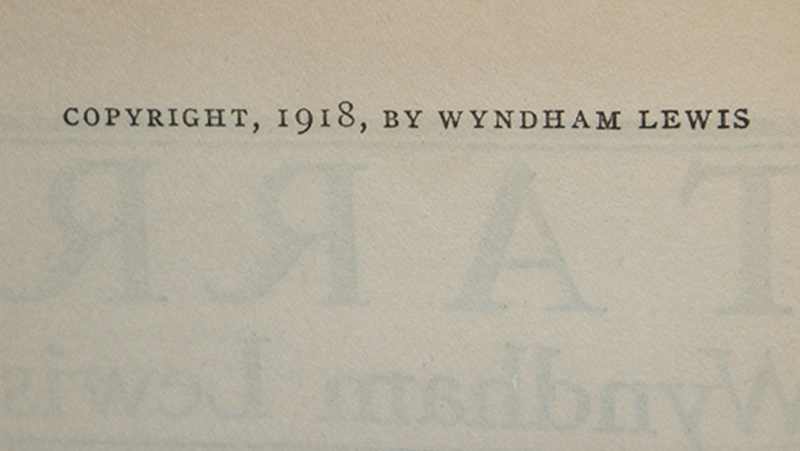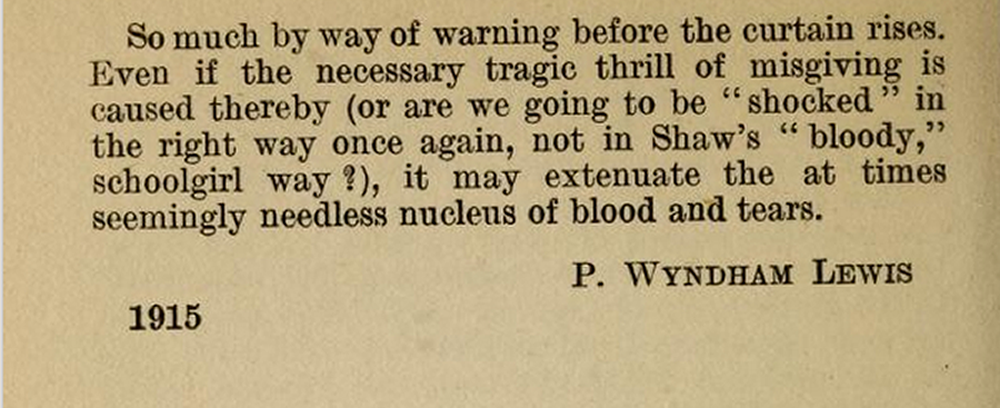Last time I wrote, we had no digital editions of Wyndham Lewis’s Tarr. Now, a mere month later, we’ve got two—excellent scans of both the Egoist Press edition of 1918 and the 1928 Chatto & Windus. The former, scanned at our request by the University of Toronto localization of the Internet Archive, is now available publicly.
There are still other versions to get hold of: the serialized version that appeared in the periodical The Egoist in 1916-17, the American Knopf edition of 1918, and the Methuen edition of 1951—each of which is which is substantially different from the two versions we now have. But the Egoist 1918 and the Chatto & Windus 1928—respectively the most “definitive” of the early versions and the version that Lewis himself wished to be preserved—are the most significant texts for our purposes.
So now the business of versioning begins. Initially our plan had been to mark up our texts in the TEI encoding language, identifying in advance significant features that we wanted to track. For instance, we might have tagged all the epithets used to designate the character Tarr in the different versions (his nicknames include Sorbet, from his middle name Sorbert), and then automatically compared all such tagged nominations. However, we have decided instead to compare un-tagged plain text. The idea is not to draw conclusions prematurely. Rather than deciding ahead of time what specific differences we’re looking for, we will simply aim to detect every difference, word-by-word, between the editions, and see what comes out. By comparing plain text files, we maximize our potential to be surprised by the results. Then our task becomes to interpret the differences that most surprise us.
Those who have studied closely the various versions of Tarr have, of course, already noticed certain differences. Some of the more general reflections belong to William H. Pritchard, who detected a “thicken[ing]” of description as Lewis becomes more willing “to tell us about his characters, what they look like, what they are comparable with” (Wyndham Lewis, 29). Far more specific variants are provided in Stephen Sturgeon’s introduction to his unpublished 2007 dissertation edition of Tarr, where he notes Lewis’s bizarre, almost pathological renaming of minor characters: Bertha’s roommate, named Clara Goenthner in the 1918 English edition, is Clare Vamber in the 1918 American edition, Clara Vamber in the manuscript revisions for the 1928 editions, Clara Lederer in the published 1928 version, and Clara Vamber once again in the 1951 version (Sturgeon 30).
Lewis liked to change things, clearly.
Because our approach to versioning is computational, we will turn up a great deal more differences than human readers have been able to detect so far. Human readers (because of our vanity, I imagine) are peculiarly attentive to things like character descriptions and character names—they are the things we tend to notice when they change, as Pritchard and Sturgeon demonstrate. There is much, however, that we don’t notice when it changes. I can’t say yet what this might be in Tarr, being a human reader myself. But we’re about to find out.
The differences I’m most curious about relate to the novel’s much-discussed (and in some quarters infamous) representations of female characters, politics, and violence. In a text so often described as misogynistic, how do representations of women change between versions? Where does Lewis respond to criticism—and when he does, does he soften his tone or dig in his heels? In a novel so centrally concerned with German characters, how do representations of German ideas, German politics, and German culture alter when the novel moves from a context dominated by the First World War to one dominated by the rise of Fascism? Which words change their meaning in these charged political contexts—which need to be removed, and which added? And in a novel whose plot turns on a rape and a duel, how do representations of violence change between versions? Does the novel become more violent or more pacific? Does the nature of its violence alter? Is this manifest in micro-level details like punctuation and word choice? If so, how?
A question I’m particularly interested in, given my interest in the problem of voice in modernist fiction, is whether Tarr becomes more or less “dialogic” in the 1928 version—whether the revisions introduce new perspectives and points of view, or whether they serve to unify and harden the ideological world of the novel. I don’t know the answers to these questions, and I don’t know if comparing plain text versions of the Egoist and Chatto & Windus editions will help to answer them—but I’m eager to find out.
I am, in short, ready to be surprised.
Post by Adam Hammond, attached to the ModVers project, with the versioning tag. Featured images for this post care of Adam Hammond, the Thomas Fisher Rare Book Library, and the Internet Archive.


